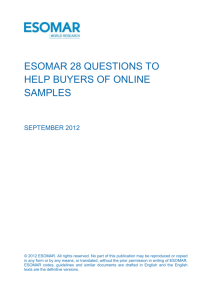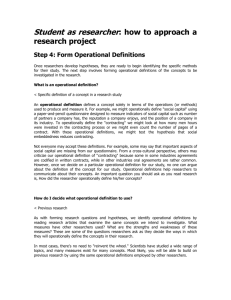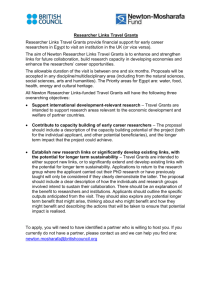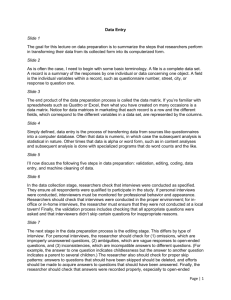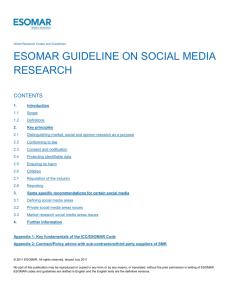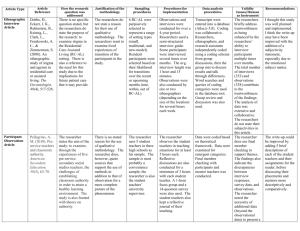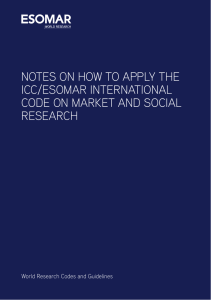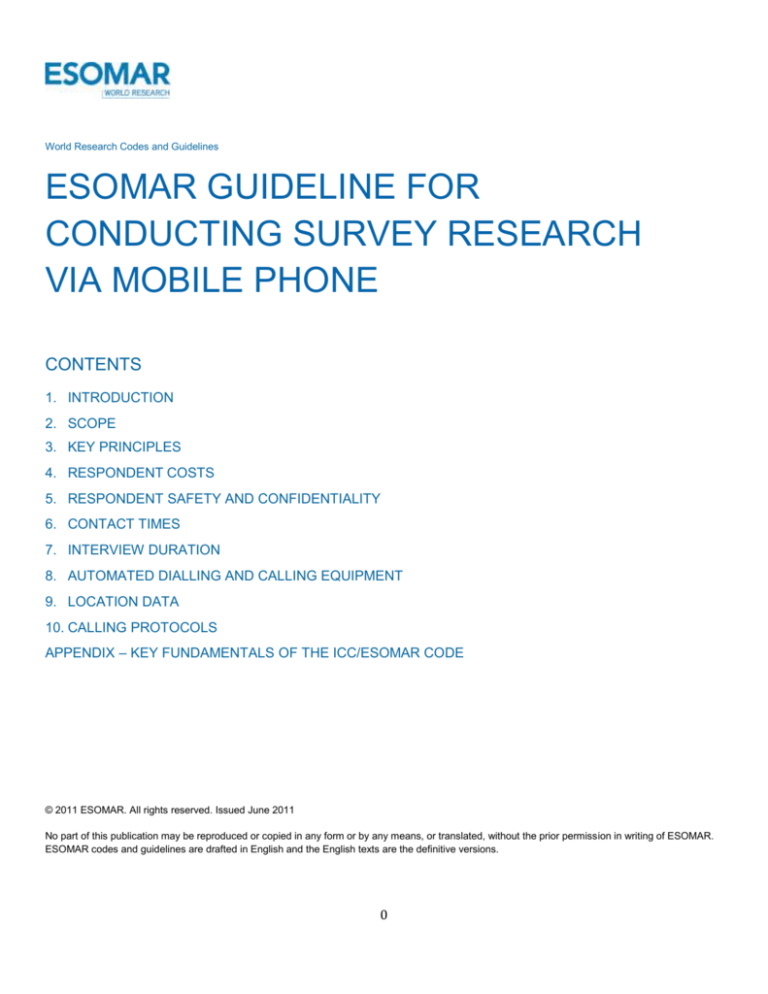
World Research Codes and Guidelines
ESOMAR GUIDELINE FOR
CONDUCTING SURVEY RESEARCH
VIA MOBILE PHONE
CONTENTS
1. INTRODUCTION
2. SCOPE
3. KEY PRINCIPLES
4. RESPONDENT COSTS
5. RESPONDENT SAFETY AND CONFIDENTIALITY
6. CONTACT TIMES
7. INTERVIEW DURATION
8. AUTOMATED DIALLING AND CALLING EQUIPMENT
9. LOCATION DATA
10. CALLING PROTOCOLS
APPENDIX – KEY FUNDAMENTALS OF THE ICC/ESOMAR CODE
© 2011 ESOMAR. All rights reserved. Issued June 2011
No part of this publication may be reproduced or copied in any form or by any means, or translated, without the prior permission in writing of ESOMAR.
ESOMAR codes and guidelines are drafted in English and the English texts are the definitive versions.
0
BACK TO CONTENTS
1. INTRODUCTION
As mobile phones become the preferred mode of telephone communication on a global scale, it is critical for ESOMAR to
establish clear guidance on the conduct of market, social and opinion research via mobile phone. The aim is to promote
professional standards, best practices, and respectful relationships with the individuals being called and to assist
researchers in addressing legal, ethical, and practical considerations when conducting research via mobile phone.
Mobile phone technology and communications have grown rapidly in some countries and at a slower pace in others, and
mobile communication laws and regulations are still evolving. Only a few countries have addressed the legal parameters
for unsolicited communication and interaction with mobile phone users. The regulatory dimension is complicated by the
multiple communication mediums that the mobile phone provides to the user.
Further, there may be national laws that pertain specifically to the mobile phone user, e.g., restrictions on using mobile
phones while driving. Such regulations indirectly affect, and could potentially be construed as establishing legal liability
for a researcher contacting a potential survey participant via mobile phone.
Given the above conditions, it is critical that the researcher is aware of and respects regional, national and local laws and
regulations and relevant cultural dispositions which may mandate a stricter standard of practice than that being required in
this guideline.
The guideline may well apply to any form of telephone research project even if is intended to contact land-lines since it
may be impossible for researchers to identify whether a given telephone number relates to a fixed-line phone or a mobile
and a fixed-line number may be set to divert to a mobile.
2. SCOPE
The ICC/ESOMAR International Code on Market and Social Research requires that the same fundamental ethical and
professional principles which govern face to face, mail and online research also apply to research via mobile phone (see
Appendix). This guideline must therefore be read in conjunction with the ICC/ESOMAR International Code and other
ESOMAR guidelines available at www.esomar.org.
While recognising that many mobile phones and mobile devices permit the use of online research methodologies,
including e-mail and web surveys, the ESOMAR Guideline for Online Research covers research using email, browserbased or downloaded applications and this Guideline for Research via Mobile Phone applies to research conducted by
using voice or text message (SMS) to contact respondents on their mobile phones. If a combination of mobile and online
is used, e.g. mobile phone to contact and internet browser to respond, then the appropriate parts of each guideline should
be applied.
3. KEY PRINCIPLES
As a general rule, researchers knowingly calling or sending text messages to a mobile phone for the purpose of
conducting a survey shall observe the principles of respect and disclosure that are practised in fixed-line telephone
research in line with the ICC/ESOMAR International Code. These include identification of the calling party, the identity of
the organisation that will receive the data if the company carrying out the call is only providing data collection and not
analysis, notification as to the purpose of the call/survey (see the ICC/ESOMAR Code Notes on transparency for more
details), the voluntary nature of participation, the guarantee of confidentiality and consideration of local expectations about
appropriate times for telephone calls.
Due to the nature of mobile phones and the patterns of use that have evolved over time there are a range of additional
legal and ethical considerations to be observed. While these considerations may vary by country and culture it is
1
BACK TO CONTENTS
essential that researchers understand these variations and adapt their survey protocols accordingly. For instance, while
most legislation restricts unsolicited calls for commercial purposes but not market research, it is mandatory to consult and
apply research-specific do-not-contact lists for mobile as well as fixed line phones if such exist. In addition, researchers
should be aware that the mobile phone service provider may cut the service should they receive a complaint about
unsolicited approaches by text or other electronic messages to potential respondents. Researchers are therefore required
to verify that individuals contacted by such means for research have a reasonable expectation that they will receive a
contact for research (see ESOMAR Guideline for Online Research, section 2.2).
If calling, researchers must remain mindful of concerns about privacy and intrusion and politely terminate the call when it
becomes apparent that the recipient is not in a position or does not wish to take the call, is not competent, or is a child
(unless the researcher receives consent from an appropriate adult to proceed with the call). The legally and socially
accepted age of children varies from country to country. If the respondent is a child, the researcher must not go further
with the interview unless consent is obtained from a parent or legal guardian to invite a child to participate in a research
survey (see ESOMAR Guideline on Interviewing children and young people, section B 10).
4. RESPONDENT COSTS
In some countries, calls to mobile telephones, unlike fixed line calls, can involve a charge to both the caller and the
recipient. Also, in instances where survey calls are made to mobile numbers across regional or national boundaries,
additional “roaming” charges may be incurred by the called party and this can also apply to sending and receiving SMS.
Respondents using mobile phones to take part in surveys may incur air-time, roaming or data costs in so doing. If
possible, the researcher should design the study so that the respondent incurs no cost. If this is not possible, the
researcher must be prepared to compensate respondents for their costs. Where mobile respondents are added to a panel
or sampling database the issue of cost and compensation should be agreed at the “sign up” stage.
5. RESPONDENT SAFETY AND CONFIDENTIALITY
Due to the nature and usage patterns of mobile telephones researchers sometimes will contact potential respondents who
are engaged in an activity or in a setting not normally encountered in fixed-line calling. This might include driving a
vehicle, operating machinery, walking in a public space, or when the caller is in another country/time zone. The
researcher has an obligation to take all reasonable precautions to ensure that respondents are not harmed or adversely
affected as a direct result of participating in an interview. Therefore, where it is known that the call is to a mobile number
or there is cause to believe this to be the case, the researcher should confirm whether the potential respondent is in a
situation where it is legal, safe and not inconvenient to take the call. If the researcher does not receive confirmation, then
the call should be terminated while allowing the possibility of making further attempts at another time.
Furthermore, a researcher might contact a potential respondent who is engaged in an activity or in a work or social
situation where others may overhear the call and confidentiality is compromised. Since a respondent could be reached in
a public or semi-private space, the researcher must consider the nature of the survey content in light of the possibility that
the respondent might be overheard and personal information or behaviour inadvertently disclosed or responses modified
on account of the respondent’s situation. If appropriate, the call should be rescheduled to another time or location when
confidentiality will not to be compromised.
Researchers should be aware that any research data stored locally on the respondent’s phone is potentially available to
others should the device be stolen or used by another person For these reasons, special care should be taken if using
SMS to return data, as the text message may be stored in the sent messages file of the phone. It is good practice to warn
respondents who will be using SMS to send responses of this and to send a final message at the end of the research
2
BACK TO CONTENTS
reminding respondents to delete research replies in their sent mail. This requirement must be observed if sensitive data is
being collected.
6. CONTACT TIMES
A number of countries have laws or standards that specify calling hours allowed for unsolicited calls of any type and these
should be observed for surveys via mobile phones as well. In the absence of such requirements, researchers should
observe the same calling hours as for fixed-line phone surveys. For telephone surveys in the business to business sector,
acceptable times are implicit in the office hours of the business concerned.
Similar attention should be paid to the sending of SMS text messages to mobile phones in order to avoid the respondent
receiving the message received alert outside “normal hours”.
Mobile phone numbers rarely indicate the respondent’s location and it is therefore incumbent on the researcher to
anticipate that the person being contacted might be in a different time zone, and to verify the convenience of the time,
location and situation.
7. INTERVIEW DURATION
While there is little empirical evidence, some researchers report anecdotally that mobile telephone respondents are more
difficult to keep online than are respondents called on fixed lines. It may well be that the nature of mobile technology
means that respondents are more easily distracted or more likely to lose concentration, or that the call is more likely to be
interrupted or dropped. In addition, the respondent’s environment may change during the course of an interview to one
where safety or confidentiality is at risk. The researcher should take these issues into consideration and ensure that the
interview length is kept as short as possible.
8. AUTOMATED DIALLING AND CALLING EQUIPMENT
Researchers should note that a number of countries restrict the use of auto-diallers and other automated dialling
equipment including predictive diallers1. Some countries2 may permit the use of such equipment only if a respondent has
given prior explicit consent (for example, as a member of an opt-in panel) to be dialled by automated dialling equipment.
Where automated diallers are permitted and used, “abandoned or silent calls”, where no live interviewer is immediately
available, are not allowed.
9. LOCATION DATA
It is now possible to capture additional data from interactive mobile devices and smartphones such as real time location
data. ESOMAR’s Guideline on Passive Data Collection addresses this issue. The researcher must have the respondent’s
permission before processing it.
1
This includes Germany and the UK.
2
This includes the US
3
BACK TO CONTENTS
10. CALLING PROTOCOLS
Some people consider their mobile phone to be a personal and private instrument. The researcher has an obligation to
be sensitive to these privacy concerns. It is appropriate for the calling protocols for research via mobile phone to differ
from the practices that are used in fixed-line telephone research. For example, the researcher should consider limiting the
number and pattern of call-backs when contacting a known mobile number.
In line with the ICC/ESOMAR Code requirement that researchers shall identify themselves, calls to mobile numbers
should be set to allow the display of the caller’s number where this is possible and this facility should not be deliberately
suppressed. If the researcher chooses to leave a voicemail message for a potential respondent (who may have to pay to
retrieve the message) then this message should detail how the researcher will offer to recompense for the cost of
retrieval.
Wherever feasible, it should be made possible for the called party to contact the researcher by calling the number
displayed to establish the researcher’s identity. It is good practice to provide a toll-free contact number, recognising that
the respondent may need to call the researcher over a fixed-line.
FURTHER INFORMATION
Queries about implementing the Guideline should be sent to the ESOMAR Professional Standards Committee,
professional.standards@esomar.org
Project Team
Diane Bowers, President, CASRO (Co Chair of Project Team and member of ESOMAR Professional Standards
Committee)
Bill Blyth, Global Methods Director, TNS, UK (Co Chair of Project Team and member of ESOMAR Professional Standards
Committee)
Keith Bailey, Senior Manager Product Development – Research and Testing, Nokia Mobile Phones, UK
Reg Baker, COO, Marketing Strategies, USA
Dr. Lorenz Graf, CEO of Global Park
AJ Johnson, VP of Global Operations, Ipsos Open Thinking Exchange
Peter Milla Consultant to CASRO
Guy Rolfe, Global Mobile Knowledge Leader, Kantar Operations
Pravin Shekar, Founder, The Social Catalyst, Kreator-in-chief, Krea, India
Tom W Smith, Director of the General Social Survey, National Opinion Research Center/University of Chicago and Vice
President and President-Elect, WAPOR
Dr. Tim Snaith, Chief Research Officer, OnePoint Global
John O’Brien, Consultant to ESOMAR Professional Standards Committee
4
BACK TO CONTENTS
APPENDIX - KEY FUNDAMENTALS OF THE ICC/ESOMAR CODE
The Code is based on these key fundamentals:
1.
2.
3.
4.
5.
6.
7.
8.
Market researchers shall conform to all relevant national and international laws.
Market researchers shall behave ethically and shall not do anything which might damage the reputation of market
research.
Market researchers shall take special care when carrying out research among children and young people.
Respondents’ cooperation is voluntary and must be based on adequate, and not misleading, information about the
general purpose and nature of the project when their agreement to participate is being obtained and all such
statements shall be honoured.
The rights of respondents as private individuals shall be respected by market researchers and they shall not be
harmed or adversely affected as the direct result of cooperating in a market research project.
Market researchers shall never allow personal data they collect in a market research project to be used for any
purpose other than market research.
Market researchers shall ensure that projects and activities are designed, carried out, reported and documented
accurately, transparently and objectively.
Market researchers shall conform to the accepted principles of fair competition.
END OF DOCUMENT
5


